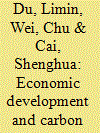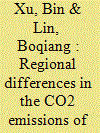|
|
|
Sort Order |
|
|
|
Items / Page
|
|
|
|
|
|
|
| Srl | Item |
| 1 |
ID:
117252


|
|
|
|
|
| Publication |
2013.
|
| Summary/Abstract |
In the last two decades, feed-in tariffs (FIT) have emerged as one of the most popular policies for supporting renewable electricity (RES-E) generation. A few studies have assessed the effectiveness of RES-E policies, but most ignore policy design features and market characteristics (e.g. electricity price and production cost) that influence policy strength. We employ 1992-2008 panel data to conduct the first econometric analysis of the effectiveness of FIT policies in promoting solar photovoltaic (PV) and onshore wind power development in 26 European Union countries. We develop a new indicator for FIT strength that captures variability in tariff size, contract duration, digression rate, and electricity price and production cost to estimate the resulting return on investment. We regress this indicator on added RES-E capacity using a fixed effects specification and find that FIT policies have driven solar PV development in the EU. However, this effect is overstated without controlling for country characteristics and is concealed without accounting for policy design. We do not find robust evidence that FIT policies have driven wind power development. Overall, we show that the interaction of policy design, electricity price, and electricity production cost is a more important determinant of RES-E development than policy enactment alone.
|
|
|
|
|
|
|
|
|
|
|
|
|
|
|
|
| 2 |
ID:
161488


|
|
|
|
|
| Summary/Abstract |
The study examines factors influencing non-performing loans (NPLs) for Indian banks. The analysis contributes by including restructured advances also in addition to standard measures of asset quality that provides comprehensive picture of pressure on banks’ balance sheet. Moreover, Bayesian technique with multivariate t-distributed prior is applied for robust estimation. Utilizing quarterly dataset from 2005 to 2015, strong persistence of bad assets is clearly evident. Bank-specific characteristics such as growth of advances, profitability and net interest margin are significant determinants. Among macro-factors, high growth rate is having retarding impact on bad assets. Moreover, ownership effect is having differential behaviour with state-owned banks being most vulnerable.
|
|
|
|
|
|
|
|
|
|
|
|
|
|
|
|
| 3 |
ID:
112726


|
|
|
|
|
| Publication |
2012.
|
| Summary/Abstract |
This paper investigates the driving forces, emission trends and reduction potential of China's carbon dioxide (CO2) emissions based on a provincial panel data set covering the years 1995 to 2009. A series of static and dynamic panel data models are estimated, and then an optimal forecasting model selected by out-of-sample criteria is used to forecast the emission trend and reduction potential up to 2020. The estimation results show that economic development, technology progress and industry structure are the most important factors affecting China's CO2 emissions, while the impacts of energy consumption structure, trade openness and urbanization level are negligible. The inverted U-shaped relationship between per capita CO2 emissions and economic development level is not strongly supported by the estimation results. The impact of capital adjustment speed is significant. Scenario simulations further show that per capita and aggregate CO2 emissions of China will increase continuously up to 2020 under any of the three scenarios developed in this study, but the reduction potential is large.
|
|
|
|
|
|
|
|
|
|
|
|
|
|
|
|
| 4 |
ID:
099287


|
|
|
|
|
| Publication |
2010.
|
| Summary/Abstract |
Despite the increasing amount of literature available on renewable energy, the empirical analysis about drivers promoting renewables remains scarce. We have analyzed those drivers for European Countries. Over an extended period of time (1990-2006) we used panel data techniques, namely the fixed effects vector decomposition. The results suggest that both the lobby of the traditional energy sources (oil, coal, and natural gas) and CO2 emissions restrain renewable deployment. The objective of reducing energy dependency appears to stimulate renewable energy use. Our results robustly support the EU decision to create a directive promoting the use of renewable sources (Directive 2001/77/EC). We also offer suggestions with regards to the design of appropriate policies towards renewable energy deployment.
|
|
|
|
|
|
|
|
|
|
|
|
|
|
|
|
| 5 |
ID:
150391


|
|
|
|
|
| Summary/Abstract |
Identifying the key influencing factors of CO2 emissions in China's iron and steel industry is vital for mitigating its emissions and formulating effective environmental protection measures. Most of the existing researches utilized time series data to investigate the driving factors of the industry's CO2 emission at the national level, but regional differences have not been given appropriate attention. This paper adopts provincial panel data from 2000 to 2013 and panel data models to examine the key driving forces of CO2 emissions at the regional levels in China. The results show that industrialization dominates the industry's CO2 emissions, but its effect varies across regions. The impact of energy efficiency on CO2 emissions in the eastern region is greater than in the central and western regions because of a huge difference in R&D investment. The influence of urbanization has significant regional differences due to the heterogeneity in human capital accumulation and real estate development. Energy structure has large potential to mitigate CO2 emissions on account of increased R&D investment in energy-saving technology and expanded clean energy use. Hence, in order to effectively achieve emission reduction, local governments should consider all these factors as well as regional heterogeneity in formulating appropriate mitigation policies.
|
|
|
|
|
|
|
|
|
|
|
|
|
|
|
|
| 6 |
ID:
177385


|
|
|
|
|
| Summary/Abstract |
This aim of the paper is to investigate on the strength of EU renewable energy policies and of internal barriers to energy investments. Using a novel approach based on spatial econometric methods, the paper contributes to the debate on the effectiveness of policies supporting renewable energy investments in the EU member states. The empirical analysis is based on estimates from spatial econometric models that combines independent variables with a weighting scheme of trade linkages between member states. It allows to show how trade relationships can play a role in shaping green energy policies. In fact, technological skills are transferred together with goods and services, trade flows represent an exogenous factor correlated with green investments.
|
|
|
|
|
|
|
|
|
|
|
|
|
|
|
|
|
|
|
|
|